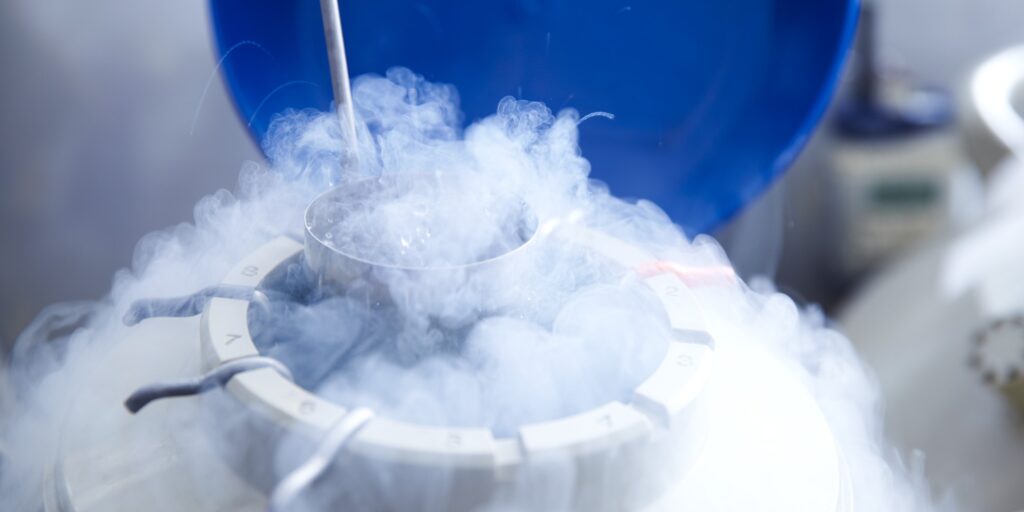
Semen freezing, also known as sperm cryopreservation, is a process used to preserve sperm cells for future use. This technique is widely utilized by individuals and couples who wish to preserve fertility due to medical, personal, or professional reasons. Sperm freezing is a crucial component of assisted reproductive technologies (ART) and has helped countless individuals achieve parenthood, even years after sperm collection.
Reasons for Semen Freezing
Semen freezing is performed for a variety of reasons, including medical necessity, lifestyle choices, and fertility preservation. Below are some of the common reasons why individuals opt for sperm cryopreservation:
1. Medical Reasons
- Cancer Treatment: Chemotherapy and radiation therapy can damage sperm production. Freezing sperm before treatment ensures fertility preservation.
- Surgical Procedures: Some surgeries, such as testicular or prostate surgery, may impair sperm production.
- Hormonal Treatments: Certain treatments for gender transition or other conditions can lead to infertility.
2. Lifestyle and Career Considerations
- Delayed Parenthood: Many men choose to freeze sperm to have children later in life when fertility might decline.
- High-Risk Professions: Military personnel, athletes, and individuals in hazardous occupations may freeze sperm in case of injury or exposure to harmful substances.
- Frequent Travel: Individuals who travel frequently or work in remote locations may freeze sperm to ensure availability for ART procedures.
3. Assisted Reproductive Technologies (ART)
- In Vitro Fertilization (IVF): Sperm freezing is commonly used in IVF procedures where fresh sperm collection may not be possible.
- Intrauterine Insemination (IUI): Frozen sperm can be used for IUI when partners are not available for fresh sperm collection.
- Donor Sperm: Donors freeze sperm for individuals and couples who require donor sperm for conception.
The Semen Freezing Process
Semen freezing is a multi-step process that ensures the viability of sperm cells after thawing. The process involves the following key steps:
1. Semen Collection
- The sperm sample is typically collected through masturbation in a private collection room at a fertility clinic.
- In cases where ejaculation is not possible, sperm can be retrieved through surgical procedures such as testicular sperm aspiration (TESA) or testicular sperm extraction (TESE).
- Abstinence from ejaculation for 2-5 days before collection is recommended to optimize sperm quality.
2. Semen Analysis
- After collection, the sample undergoes a detailed semen analysis to assess sperm count, motility, morphology, and overall quality.
- If the sample meets the required criteria, it proceeds to the freezing stage.
3. Cryoprotectant Addition
- A special cryoprotectant solution is added to the sperm sample to protect the cells from damage during freezing.
- The solution helps prevent the formation of ice crystals that could rupture sperm membranes.
4. Gradual Cooling
- The sample is gradually cooled to subzero temperatures using specialized equipment.
- The temperature is lowered in controlled stages to prevent thermal shock.
5. Storage in Liquid Nitrogen
- The sperm is stored in liquid nitrogen at -196°C (-321°F).
- Samples are typically stored in small, labeled vials for easy identification and retrieval.
Sperm Storage Duration and Viability
Sperm can be stored indefinitely in liquid nitrogen without losing quality. However, certain factors can influence the viability of frozen sperm:
- Initial Sperm Quality: Higher-quality sperm samples tend to have better post-thaw survival rates.
- Freezing and Thawing Process: Advanced cryopreservation techniques improve sperm survival rates.
- Duration of Storage: Studies have shown that sperm frozen for decades can still be viable for successful fertilization.
Success Rates of Frozen Sperm
The effectiveness of frozen sperm depends on several factors, including sperm quality, the freezing method, and the ART procedure used. Some key considerations include:
- Thawing Survival Rate: Approximately 50-70% of sperm survive the freezing and thawing process.
- Pregnancy Success Rates: Pregnancy success rates using frozen sperm vary depending on the method of conception. IUI success rates range from 10-20% per cycle, while IVF success rates are higher.
- Multiple Samples for Better Results: Freezing multiple samples can improve the chances of successful conception in future treatments.
Risks and Considerations
While sperm freezing is generally a safe and effective method of fertility preservation, some risks and considerations include:
1. Sperm Damage During Freezing and Thawing
- Some sperm cells may not survive the freezing and thawing process.
- Advanced freezing techniques, such as vitrification, may improve survival rates.
2. Storage Costs
- Long-term storage fees vary by clinic and facility, and individuals should consider the financial aspect before committing to prolonged storage.
3. Legal and Ethical Considerations
- Some countries have specific laws regarding sperm storage duration and usage.
- Individuals should clarify legal rights regarding stored sperm, especially in cases of separation, divorce, or death.
4. Success Is Not Guaranteed
- Although frozen sperm can be successfully used in ART, pregnancy is not guaranteed and depends on multiple factors.
Advancements in Sperm Freezing Technology
Recent technological advancements have improved the success rates of sperm cryopreservation. These include:
1. Vitrification
- A newer technique that involves ultra-rapid freezing, reducing ice crystal formation and improving sperm survival rates.
2. Microfluidic Sperm Sorting
- Helps select the best sperm for freezing, enhancing post-thaw sperm viability and ART success.
3. Artificial Intelligence (AI) in Sperm Selection
- AI is being integrated into fertility clinics to improve sperm analysis and selection, optimizing the chances of successful conception.
Ethical and Legal Considerations
Semen freezing raises various ethical and legal questions that individuals should consider:
1. Consent and Usage Agreements
- Clear agreements should be in place regarding how the sperm can be used, especially in cases of unexpected death or separation.
2. Sperm Donation Regulations
- Different countries have varying legal requirements for sperm donation, including anonymity and parental rights.
3. Religious and Cultural Views
- Some religions and cultures have specific perspectives on sperm freezing and ART that individuals may need to consider.

